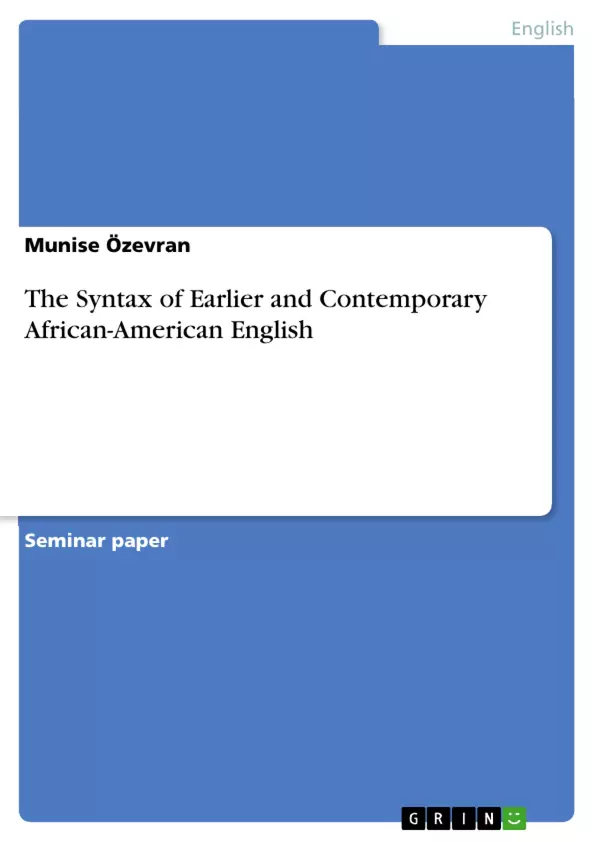This term paper focuses on the grammar of early and today’s African-American English, as well as its origin, its history, its development and the areas in which it is commonly spoken today. More precisely the paper will outline the construction of African-American English and will further provide a comparison of early and contemporary AAE by discussing the lyrics of a slave song in contrast to two songs by Nicki Minaj and 50 Cent in regards to syntax. Even though AAE consists of more than just grammatical distinctions such as the phonological, morphological and semantical, the focus here will solely lie on the syntax.
Inhaltsverzeichnis (Table of Contents)
- Introduction
- Main Part
- The History of African Americans and their Speech
- Its Linguistic Structure and Word Formation
- Overview of Contemporary AAVE
- Grammar of Contemporary AAVE
- Differences between earlier and contemporary AAVE
- Historical Song in Earlier AAVE, Analyzed and Compared to Songs in Contemporary AAVE
- Analysis of the Song "I don't do nobody nothin"
- Analysis of the Song "In Da Club” by 50 Cent and “Anaconda” by Nicky Minaj
- Comparison
- Conclusion
Zielsetzung und Themenschwerpunkte (Objectives and Key Themes)
This term paper investigates the grammar of earlier and contemporary African-American English, its origins, history, development, and contemporary usage. It particularly focuses on comparing earlier and contemporary AAVE by analyzing the lyrics of a slave song as a visualization for its syntax.
- The historical development of African-American English
- The linguistic structure and word formation of African-American English
- The grammatical differences between earlier and contemporary African-American English
- The analysis of historical and contemporary songs in African-American English
- The comparison of early and contemporary African-American English through song analysis
Zusammenfassung der Kapitel (Chapter Summaries)
The introduction explores the origins of African-American English, highlighting its development from the arrival of African slaves in the 17th century. It discusses the historical and social context of the language's emergence, emphasizing the influence of African tribal languages and the ongoing evolution of the dialect. The chapter also lays out the scope of the paper, focusing on the grammar of early and contemporary African-American English.
The main part delves into the historical context of African Americans and their speech. It examines the origins of slavery in America, tracing the journey of African slaves from the 17th century and outlining the various influences that shaped their language. The section further explores the linguistic structure and word formation of African-American English, providing an overview of contemporary AAVE and its differences from earlier versions of the language. It also examines the grammatical differences between earlier and contemporary AAVE, highlighting the unique characteristics of the dialect.
The chapter dedicated to historical songs in earlier AAVE and their comparison with contemporary songs delves into the analysis of specific songs. It analyzes the syntax of the song "I don't do nobody nothin" as a representation of earlier AAVE. It also explores the syntax of contemporary songs, such as "In Da Club" by 50 Cent and "Anaconda" by Nicki Minaj, providing a comparison between historical and contemporary AAVE through song analysis.
Schlüsselwörter (Keywords)
This paper focuses on African-American English, its grammar, syntax, and historical development. Key concepts include earlier and contemporary AAVE, the influence of African languages, the impact of slavery on language development, song analysis, and linguistic comparison.
- Citation du texte
- Munise Özevran (Auteur), 2018, The Syntax of Earlier and Contemporary African-American English, Munich, GRIN Verlag, https://www.grin.com/document/1330848



